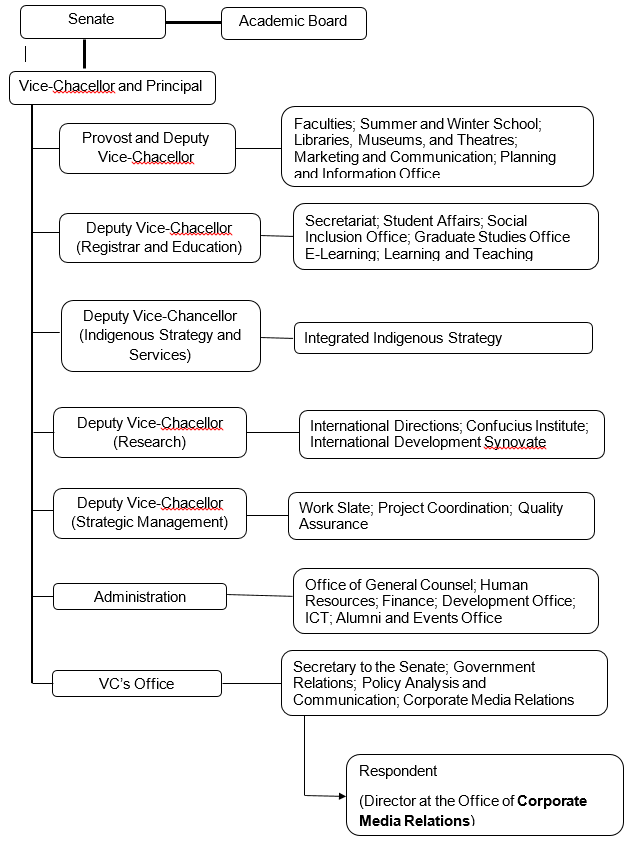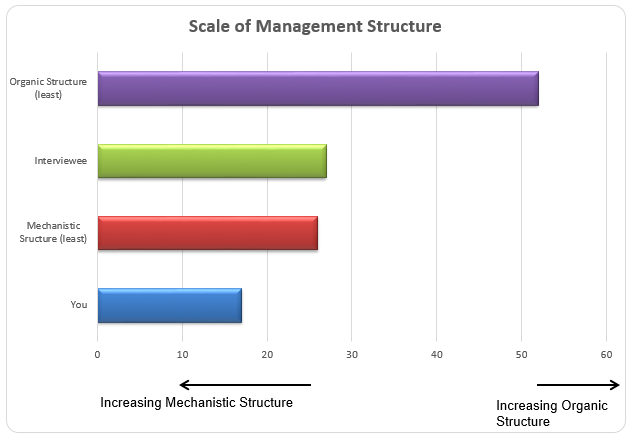Organizational Structure: The Sydney University
(Interviewee is Director at the Office of the Corporate Media Relations)

Please tick (√) in the respective box for the right response, use the key provided;
- Strongly Disagree,
- Disagree,
- Neutral,
- Agree,
- Strongly Agree.
Total Score, Employee: ∑= 27
Please tick (√) in the respective box for the right response, use the key provided;
- Strongly Disagree,
- Disagree,
- Neutral,
- Agree,
- Strongly Agree.
Total Score, You: ∑= 17
Scale of Management Structure

Organizational structure of the institution
Based on the calculated score (summation of the adjusted score [subtracting original score for each question from 6]) derived from selected questions that provide precision on whether the organization structure of the institution (that is, The Sydney University) is organic or mechanistic. Calculated scores that are 52 or above indicate that the management structure is organic, while when the score is 26 or below then it is mechanistic. This means scores that are higher and away from 52 infer an increasing degree of idealness into the organic structure, while scores below and away from 26 imply a more ideal mechanistic structure (Samson and Daft, 2009, p.402).
Questions are chosen to deduce whether the organization structure of the institution was mechanistic or organic were1, 2, 6, 7, 9, 11, and 13. The calculated score for the interviewee (Director at the Office of the Corporate Media Relations) was 27. The score is just above the least mechanistic score, hence the interviewee perceives that the institution’s management structure is not mechanistic. The interviewee strongly disagreed (score of 1) that lines of authority are clear and precisely defined.
The interviewee disagreed (score of 2) that his work would be considered routine; a known way is established to do major tasks he encounters as well as he seldom exchanges ideas or information with people doing other kinds of jobs. He further disagreed that decisions relevant to his work are made above him and passed down; job descriptions are written and up-to-date for each job as well as a manual of policies and procedures are available to use when a problem arises.
Media relations
The Director in the Office of Media Relations plays an oversight role in the realization of the functions of the office. Media relations involve generating appropriate publicity as well as fostering desirable news coverage for the operations of the institution. This means the information package suit the medium of conveyance. The size and diversity of the institution’s operations determine the public relations message to be conveyed. The public relations message should be delivered timely, right location as well as target the right audience. This means there should be a clear known way for undertaking the major tasks in media relations.
Yang and Chiou (2010, p.224) when studying factors influencing public relations practice in higher learning institutions explain that media relations should be designed to earn goodwill, improve public perception towards the education worth as well as increase dual and balanced communication between universities and their environs. Also, generate substantive and reliable information to the public and the staff as well as be incorporated into the planning and decision-making roles. There is no single checklist of functions for university media relations. This means University media relations is not a routine job.
However, general functions include public relations, image building, public relations programming and planning, marketing, student recruitment, in-house and external communications as well as fundraising (Yang and Chiou, 2010, p.224). This shows that there is a need for a constant exchange of ideas or information with people doing other kinds of jobs.
The top rank university presents the highest hierarchy for the management of media relations functions. However, major decisions and determinants of media relations will depend on the practitioner, thus the influence is the dual way; that is both top-down and bottom-up. Yang and Chiou (2010, p.225) view that there exists a strong relationship between the crisis in education and media relations functions. This has influenced the degree of elevation of media relations practice in the hierarchy of management such that those with higher crisis cases have manager levels while those with low crisis issues media relations practice is at the technician level.
This means that there is a clear and precise line of authority to handle media relations. The crisis will lead to public opinion attacks as well as negative news coverage. Yang and Chiou (2010, p.225) explain that decision making in matters on media relations are all-inclusive (democratic); however, there exist administrative levels designed to give those at higher ranks more authority in decision-making than those at the lower ranks.
The individual characteristics of the media relations manager contribute to the successful performance in media relations (University of Hawaii, 2002). Among the characteristics desired to manage media relations include stability and forward-thinking, self-driven and enthusiasm, apt communication skills, a broad range of knowledge and intellectual curiosity as well as broad tolerance of frustration and style. To get a person who merits these qualities there is a need for an up-to-date job description.
Work experiences play an important role in helping public relations practitioners gain extra confidence, expertise, and professional acumen to serve in educational media relations. Experience enhances work performance. Media experiences such as journalistic background give the practitioner the basis of understanding of media gatekeeper values as well as operations involved such as news dissemination and coverage. For institutions of higher learning to enhance the efficiency and operations of educational media relations, there is a need to comprehend all aspects of interaction as well as the integral role played by mainstream education.
Those institutions with media relations at the technician level are involved in fewer strategic functions and less policy-making compared to those that have established media relations at the managerial level. Nevertheless, research has established larger units in media relations perform better than smaller ones. Moreover, media relations functions should be evaluated to answer whether the strategic goal was achieved or whether the institution’s activities generated optimal news value (Fridman and Fla, 2001).
This means drawing of policies should provide a paradigm shift that drives towards a proactive and anticipative approach in achieving the preset goals (Werder, 2006, p.335). Also, structures should be in place to review policy documents governing the institution’s media relations operations to align and remain competitive with the advancing market.
Switch in media technologies should not be driven majorly by fashion but augmenting end solutions to the institution’s problems. These media relations interfaces adopted should provide optimal solutions, both in terms of value for money as well as addressing problems. This not only tests the proficiency of the media relations manager but also puts the organization structure on the spot (University of Maryland, 2009, p.2).
References
Fridman, S. E., and Fla, G. (2001). Media Relations. Web.
Samson, D., and Daft, R. L. (2009). Management (3rd Asia Pacific ed.). South Melbourne, Vic: Cengage Learning Australia.
The University of Hawaii. (2002). Media Relations Policy and Procedures. Web.
The University of Maryland. (2009). Media Relations Policy. Web.
Werder, K. P. (2006). Responding to Activism: An Experimental Analysis of Public Relations Strategy Influence on Attributes of Publics. Journal of Public Relations Research 18(4), 335-356.
Yang, M-L, and Chiou, W-B. (2010). A countrywide study on factors influencing public relations practice in higher education in Taiwan. Asia Pacific Educ. Rev. 11, 223–233.